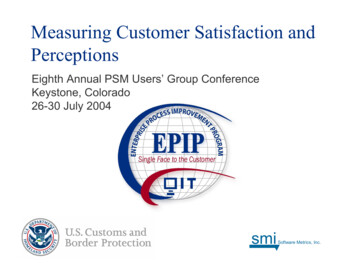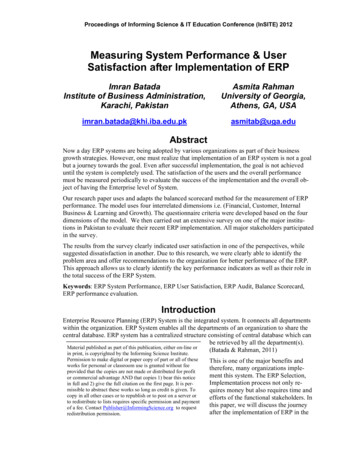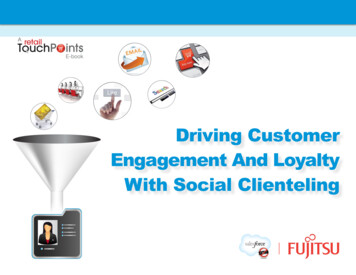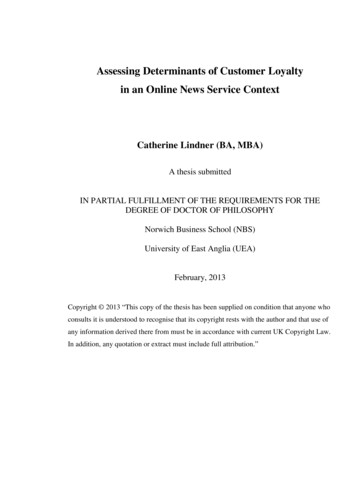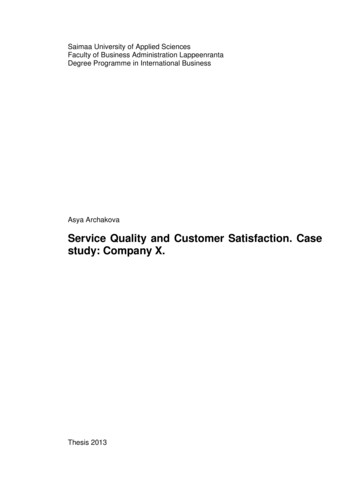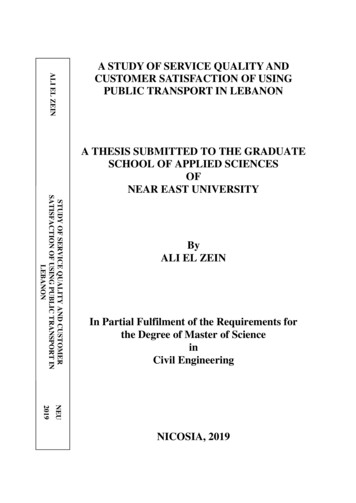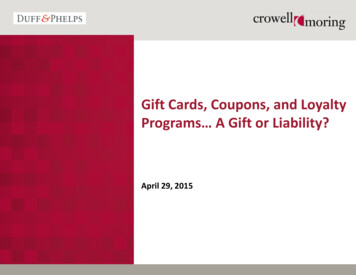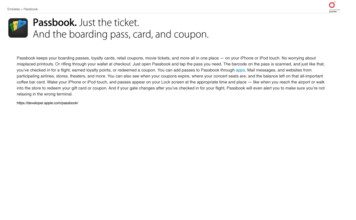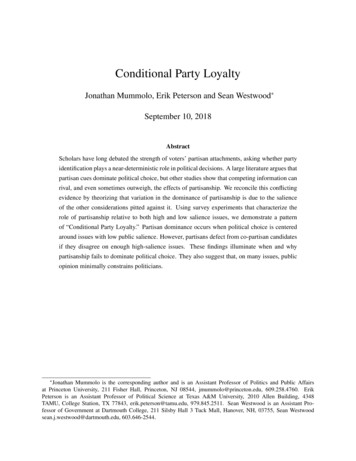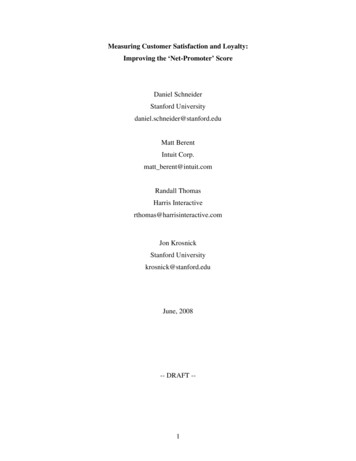
Transcription
Measuring Customer Satisfaction and Loyalty:Improving the ‘Net-Promoter’ ScoreDaniel SchneiderStanford Universitydaniel.schneider@stanford.eduMatt BerentIntuit Corp.matt berent@intuit.comRandall ThomasHarris Interactiverthomas@harrisinteractive.comJon KrosnickStanford Universitykrosnick@stanford.eduJune, 2008-- DRAFT --1
Measuring Customer Satisfaction and Loyalty:Improving the ‘Net-Promoter’ ScoreFaced with competitive markets, companies are eager to focus their efforts on thewishes and needs of the customers to retain old customers and to attract new ones. Whilecorporate communication directed at the customer is conducted by advertisement, instore promotion, public relation efforts and a range of other means, the flow ofinformation and feedback from the customer to the company is much more limited: forexample, companies track customers’ behavior while shopping or implement voluntaryfeedback system.Representative information from a large number of customers as well as noncustomers can be collected by using structured surveys. Surveys allow companies to askquestions focused on specific topics of interest rather than relying on voluntary comments.They allow customers to communicate their attitudes about and experiences with thecompany back to the company. Surveys have become a common tool for manycompanies to learn more about their customers and ultimately improve their satisfactionwith the company and its products. The rise of customer satisfaction as an importantconcern for business leaders is not over yet: the National Retail Federation (NRF)recently released survey findings indicating that among 418 executives across 137companies in the retail industry customer satisfaction currently has the top priority(Geller, 2008).Business consultant Fred Reichheld (2003, 2006) proposed a single question asthe best and sufficient measure of customer satisfaction. Customers are asked, ‘How2
likely is it that you would recommend [brand or company X] to a friend or colleague?’,and they can respond by choosing a number between 0 to 10, with 0 labeled ‘not at alllikely’, 5 labeled ‘neutral’, and 10 labeled ‘extremely likely’. The responses to are thenaggregated and transformed into a single summary statistic, the Net-Promoter Score(NPS). A company’s Net-Promoter Score is the difference between the proportion ofcustomers placing themselves at points 9 or 10 (called ‘promoters’) and the proportion ofcustomers placing themselves between 0 and 6 (called ‘detractors’). Respondents on scalepoint 7 and 8 are called ‘neutrals’.According to Reichheld and his collaborators the Net-Promoter question is all acompany needs to ask in their customer satisfaction surveys. At most a follow-upquestion should be used to elicit reasons for the selected response option (Reichheld,2003). Their conviction that likelihood to recommend is the best measurement forbusinesses to understand the state of their customer relations is quite strong: “anindividual’s propensity for recommending a company to friends or colleagues may be themost direct gauge of customer loyalty and ultimately, financial success” (Satmetrix, 2004:7). The Net-Promoter question is the “ultimate question” (Reichheld, 2006), “[t] he onenumber you need to grow” (Reichheld, 2003) and “the single most reliable indicator of acompany’s ability to grow” (netpromoter.com, 2008).Likelihood of recommending does fit well with concepts of custom satisfactionand purchase behavior. Put simply, likelihood of recommendations leads to actualrecommendations, which leads to positive impressions in other potential customers andultimately to new purchases and growth in sales (figure 1).[INSERT FIGURE 1 HERE]3
The likelihood to recommend itself should be based on a positive attitude towardsthe company. This attitude could be measured, for example, with a question on howmuch the customer likes or dislikes the company and its products. The customer’s pastexperiences with the company, exposure to communication in mass media such asreviews and advertisement, and communication with other customers about the companywill primarily contribute to the construction of that attitude. Past experience is reflectedin the satisfaction a customer feels in his or her interactions with the company. The wordof-mouth communication is reflected by how many recommendations are given about acompany and therefore is influenced by how many people report the intention orlikelihood of recommending the company and its products. To increase sales, companieswant to increase customer satisfaction, how much respondents like their company, andhow many people are giving positive recommendations about their company whentalking to potential customers.The customer-company interactions influence satisfaction, liking and thepropensity to give future recommendations. These three concepts are connected: if acustomer is satisfied he or she is more likely to give recommendations and probablyincreases his or her liking of the company. Higher liking leads to more recommendationsas well. Higher liking and higher satisfaction turns directly into higher retention rates forthe company, but higher likelihood of recommendations would also measure the amountof word-of-mouth promotion that might occur.Reichheld (2006: 28) describes the Net-Promoter score as a measure that bothreflects “the emotional and the rational dimensions” of the relationship between thecustomer and the company. If liking and both satisfaction are precursors of the likelihood4
of recommending, the question is whether they make any additional contributions toincreased sales beyond the measured likelihood of recommending or whether likelihoodof recommending is contributing something that is not covered by asking simply aboutsatisfaction and liking.Likelihood of recommending might be a better measurement than simplelike/dislike questions or a measurement of satisfaction, because it asks the respondent tomake a commitment to future behavior. When a respondent gives recommendations he orshe is putting his or her own reputation as a trustworthy source on the line. Thiscommitment might even apply to the hypothetical measure of likelihood ofrecommending (Reichheld, 2003). Therefore, respondents might have higher incentivesto give better, that is more valid and considerate, answers than for inconsequential directquestions on attitude and satisfaction. Discussing attitudes towards the business and thepast experience with the business in terms of recommendations also might be morenatural than the abstract concept of satisfaction, because of respondents regularly engagein giving recommendations to other people as their everyday behavior.At the same time, likelihood of recommending measures the word-to-mouthcomponent of attracting new customers – a company that has many satisfied customerrecommending its products will likely attract more new customers in the future.Interpersonal communication has an important role in successful promotional campaigns.In one of the earliest election studies Lazarsfeld, Berelson and Gaudet (1944) describedthe importance of interpersonal recommendations and advice for the success of electioncampaigns. Their research triggered many investigations into the role of ‘opinion leaders’who give advice to others and are experts in their social circles (Roch, 2005). Later5
research has further extended these concepts into theories of diffusion of innovation(Rogers, 1995). The importance of interpersonal communication for successfuldissemination of innovations supports the notion that recommendations might beimportant to facilitate business growth. In a recent study, Watts and Dodds (2007), forexample, investigated the role of networks of interpersonal communication in formingpublic opinion independently from specific influentials or opinion leaders. However,other research has shown that word-of-mouth communication might only be a smallcomponent to promote business success (Godes and Mayzlin, 2004).Many businesses have adopted the Net-Promoter technique and it has changedhow many executive managers make decisions. Some companies have decided to tie thebonuses of their managers to performance on the Net-Promoter score (BusinessWeek,2006). Many business leaders believe that they can trust the Net-Promoter score and itsproperties and that it is a useful tool to guide business decisions. They talk confidentlyabout their experiences when using it as a management tool:“I have little doubt that this will be as big and long-lasting for GEas Six Sigma was.” – Peter McCabe, Chief Quality Officer, GE Healthcare(BusinessWeek, 2006).“Net Promoter gave us a tool to really focus organizational energyaround building a better customer experience. It provided actionableinsights. Every business line [now] addresses this as part of their strategicplan; it's a component of every operating budget; it's part of every6
executive's bonus. We talk about progress on Net Promoter at everymonthly operating review.” – Steve Bennett, President & CEO, Intuit Inc.1“Responses are gathered immediately following the rentalsenabling local field management to follow up quickly on problems andtarget areas for improvements. We're using the survey globally in ourworldwide car rental and Hertz network and even our licensees areparticipating.” – Michel Taride, President, Hertz Europe Ltd.2“But it's also how you measure the overall experience of yourcustomers. We use the measurement that's called NPS. It's the netpromoter score. It's very simple actually.” – Vicente Trius, President, WalMart Brazil. 3“And increasingly, as are many progressive service organizations,we're looking at this notion of net promoters [ ]; and what that gets usmore specifically is this question will you be a reference for ExpressScripts? Will you recommend this? You can ask a lot of questions, but atthe end of the day we think that that's the most important thing. And wethink that by holding ourselves to this score and planting that in ourorganization, we're holding ourselves to a higher standard.” – Ed Ignaczak,Senior Vice President Sales & Account management, Express tories/intuit.php, last accessed: 05/07/2008.Q3 2007, Hertz Corp, Earnings Conference Call – transcript by Fair Disclosure Wire.3Fall Analyst Meeting, 2007, Wal-Mart Store Inc. – transcript by Fair Disclosure Wire.4Investor Meeting, 2007, Express Scripts, Inc. – transcript by Fair Disclosure Wire.27
“[T]his is out of this book [ ], The Ultimate Question, by FredReichheld, which we have found to be very valuable. And a couple ofyears ago we started really organizing a lot of things around the netpromoters score. I won't walk through the calculation again, but it isbasically an all-in score of customer satisfaction.” – Patrick Bynre,Chairman and CEO, Overstock.com Inc.5This success shows how much a good measurement for customer satisfaction andbetter understanding of customer loyalty was needed. Fred Reichheld was known as anexpert and prolific writer on customer loyalty before publishing on the Net-Promoterscores (Reichheld, 1996; Reichheld, 2001), and the first article on the Net-Promoter scorewas published in the prestigious Harvard Business Review (Reichheld, 2003), helpinghim to reach a large audience in the business community. His arguments and evidenceconvinced them to follow his recommendation and implement the Net-Promoter score.Reichheld (2003) based his claims on initial research with data collected oncustomers of 14 different companies across six industries. In 11 of those 14 companies hefound that the Net-Promoter score performed better than other measures of customerssatisfaction in predicting actual purchase behavior on the level of individual customers.Next, he and his collaborators conducted a large data collection and investigated therelationship between growth indicators (growth in revenue, growth in shipment, etc.) andaggregated Net-Promoter scores for different companies. They found, across a variety ofindustries, that the Net-Promoter score was a strong correlate with indicators of growth(Satmetrix, 2004). They reported R2s range from .68 to .93 (for the 6 industries reportedin Reichheld (2006)).5Q2 2007, Overstock.com Inc, Earnings Conference Call, transcript by Fair Disclosure Wire.8
The success story of the Net-Promoter score is in part based on the assumptionthat it is solid science, well supported by empirical findings (Keiningham, Cooil,Andreassen, and Aksoy, 2007). However, the range of published and peer-reviewed testsof the Net-Promoter score is rather limited so far – and it has often not confirmed thebold claims made by its proponents.One important criticism questions the strength and reliability of the link betweenthe Net-Promoter score and measures of business growth. Related is the question whetherthe Net-Promoter is truly better than any other measurement and whether it is sufficienton its own as a measure of customer relations. Studies that tried to replicate the linkbetween business performance and the Net-Promoter scores often did not find statisticallysignificant relationships in several industries (Lawrie, Matta and Roberts, 2006).Similarly, the relationships were also less consistent or strong when using longitudinaldata to investigate whether changes in Net-Promoter score are related to changes ingrowth (Keiningham, et al., 2007).Reichheld (2006: 84) argues that satisfaction measures do not match the actualbehavior of customers. Specifically, he argues that a substantive amount of respondentswho describe themselves as ‘satisfied’ or ‘very satisfied’ are also defectors and do notshow the brand loyalty that one would expect. But in some studies, researchers havefound that other measures of customer relations are significant predictors of businessperformance in contrast to or beyond the variance in growth explained by the NetPromoter score alone (Lawrie, Matta and Roberts, 200
promoters score. I won't walk through the calculation again, but it is basically an all-in score of customer satisfaction.” – Patrick Bynre, Chairman and CEO, Overstock.com Inc.5 This success shows how much a good measurement for customer satisfaction and better understanding of customer loyalty was needed. Fred Reichheld was known as an
